By 11 a.m. the Teamsters are tired. They’ve been out here a couple of hours already, on the 3700 block of South Halsted, picketing in front of Allen Bros. meatpacking. They are in no mood to talk to a reporter. They don’t want to be quoted, and they certainly don’t want their picture taken. I know this because when I ask, they threaten to do something obscene with the photographer’s camera.
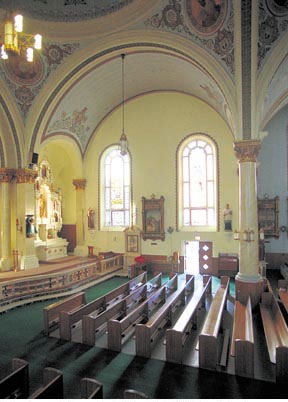 Maybe the man filming them from an unmarked car across the street has made them skittish. They say that he’s a “rent-a-pig” hired by management to watch them and periodically aim a video camera their way. One of them periodically unzips his pants and aims something else in the private investigator’s direction.
Maybe the man filming them from an unmarked car across the street has made them skittish. They say that he’s a “rent-a-pig” hired by management to watch them and periodically aim a video camera their way. One of them periodically unzips his pants and aims something else in the private investigator’s direction.
“Go take his picture,” this one says. “He’s the one you should be taking pictures of.”
Truckers blow their horns as they pass in solidarity with the strikers, who wave back in appreciation. There is little traffic besides trucks on this stretch of Halsted, which is lined with processors of beef, lamb, veal and pork.
When I ask why they won’t talk or be photographed, there are jokes about jealous lovers and “wanted” posters, but in the end, it seems, they simply don’t trust outsiders.
“It all gets twisted around,” one says. “We talk to you and then suddenly, it’s the big union screwing the little company. It’s like on the news when you hear a trucker killed a family of six, and they don’t tell you it was a pickup truck.”
The Near Southwest neighborhood of Bridgeport, directly west of Comiskey Park, is bounded roughly by the South Branch of the Chicago River, the river’s South Fork, Pershing Road and the railroad tracks east of Stewart Avenue.
If Bridgeport is not Chicago’s most colorful neighborhood, it’s definitely in the running. It has supplied Chicago with mayors for more than 50 of the last 100 years and remains the heart of the Democratic organization in Chicago. More than any other, the 11th Ward has been the home of patronage, and machine politics is the local sport, practiced enthusiastically by every bar owner, barber and street cleaner.
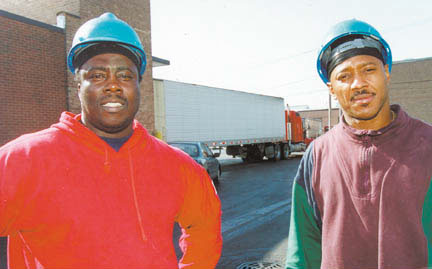 The neighborhood was settled first by the Irish and Germans, hired to build the Illinois and Michigan Canal, and later by additional waves of immigrants – Swedes, Poles, Lithuanians, Czechs and Italians. Each group formed its own enclave, developed its own churches and bakeries and guarded its precious turf, often with the aid of street gangs.
The neighborhood was settled first by the Irish and Germans, hired to build the Illinois and Michigan Canal, and later by additional waves of immigrants – Swedes, Poles, Lithuanians, Czechs and Italians. Each group formed its own enclave, developed its own churches and bakeries and guarded its precious turf, often with the aid of street gangs.
These same immigrants worked in the Union Stock Yard, which opened on the edge of Bridgeport in 1865 and supplied meat to the nation from a site that at one time, covered 475 acres. When Carl Sandburg called the city “hog butcher to the world,” he was thinking of Bridgeport.
Finley Peter Dunne famously documented neighborhood life in the 1890s in the person of a fictional Irish saloonkeeper named Mr. Dooley. The sage barman doled out commentary on the rough working conditions, shanty housing, bar brawls and variegated fabric of Bridgeport, and relayed the first inklings of something else in the place once aptly called “Hardscrabble” – a striving for respectability.
It’s easy to see how that community evolved into the Bridgeport of today. The neighborhood is still tight-knit, family-oriented, ethnic and edgy. Despite a solid gold location, just southwest of the Loop, and a strong sense of community, that old urge to improve over the years has led many residents out of the neighborhood as soon as they could afford a home in the suburbs.
A couple of new factors, however, have started in small measure to reverse this trend and have given the neighborhood hope. A booming real estate market for most of the last decade has pushed development towards Bridgeport, where comparatively low prices and a convenient location are spurring a new wave of building. As housing options increase, more residents may stay, and there already are signs that at least some of those who left are returning.
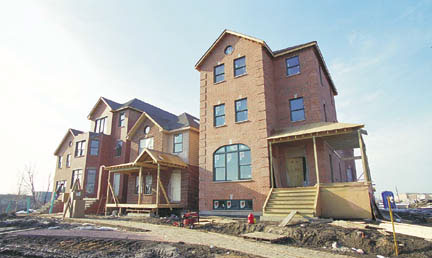 Tandem Developers recently opened Union Lofts, Bridgeport’s first major loft condo development and at press time, had sold 40 of 71 units. And Snitzer Homes feels confident enough in the area to open what is by far the largest singe-family home development in the city in Bridgeport. Bridgeport Village may include more than 400 homes when complete, along the South Fork of the river at 33rd.
Tandem Developers recently opened Union Lofts, Bridgeport’s first major loft condo development and at press time, had sold 40 of 71 units. And Snitzer Homes feels confident enough in the area to open what is by far the largest singe-family home development in the city in Bridgeport. Bridgeport Village may include more than 400 homes when complete, along the South Fork of the river at 33rd.
These projects follow numerous infill developments that have been quietly built over the last six years, many on former industrial land. The latest developments, though, are bringing a new product type and a new price range to the neighborhood, and some hope, new momentum.
Labor relations seem much healthier at Henry Kaminski, Inc., across the street from the striking Teamsters on Halsted. It’s barely noon and the crew of mostly Polish workers are finishing up their work. Five or six in white coats stand on each side of a silver table, knives in hand as they de-bone and trim fat from pork shoulders. Most of this “blade meat” will be used by Swift and companies on the east coast to make sausage. A little may go to old Italian neighbors who stop by occasionally for a pork shoulder to make their own fresh sausage.
Expertly the men flip the meat on their knives, make the cuts and toss the finished portion into a huge meat-filled bin at the end of the table.
The business was started by Jeff Kaminski’s grandfather, who sold meat off the back of a wagon in Bridgeport. He later bought a building on Halsted and Jeff’s father began to run the business, as Jeff no doubt will do when his father retires.
Kaminski employs 25 people now, including Jeff’s twin sister and three brothers in law. Most of today’s crew has been there at least 10 years. They live in the neighborhood and if one does leave the company, he’s soon replaced.
“These guys are really good workers,” Kaminski says. “But if someone quits, there’s always someone else the next day through the grapevine. There’s always someone right away, and they always know how to cut.”
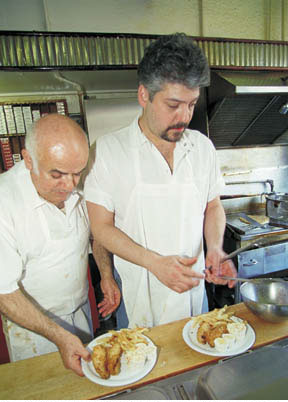 The site of Bridgeport Village already is impressive. Snitzer Homes is at work on seven model single-families on a 17-acre riverfront site that will hold a first phase of 116 homes. Developer Tom Snitzer says he is building seven models to highlight the project’s quality and variety.
The site of Bridgeport Village already is impressive. Snitzer Homes is at work on seven model single-families on a 17-acre riverfront site that will hold a first phase of 116 homes. Developer Tom Snitzer says he is building seven models to highlight the project’s quality and variety.
“One of the things that’s unique about what we’re doing is not just the size of it,” Snitzer says. “Seventy years ago, you’d have 10 or 12 architects on a block in places like DePaul and the South Side, so the homes don’t all look alike. Anything done in the last 10 years looks like it was cranked out of a cookie cutter. We wanted architectural diversity, and we wanted to demonstrate the variety and quality of the homes.”
The large, detached houses are masonry with two or three stories. The style is traditional, with front porches, freestanding garages, some bay windows and small front yards. They have three to five bedrooms, 2.5 to 4.5 baths and 2,400 to a whopping 5,270 square feet. Prices on the new homes also are pushing the neighborhood to a new level. Snitzer says the most basic homes will start in either the $350s or the $370s. He’s not sure about the high end, but based on square footage, it seems likely to be well over half a million dollars.
The median price of a single-family home in Bridgeport last year was $155,000, according to the Chicago Association of Realtors, and the most expensive house sold for $419,900. A steady trickle of new homes in the $250,000 to $400,000 range has been built and sold in recent years in the neighborhood, but the numbers are small.
Some residents say the reason more haven’t been built is that the land simply wasn’t available until now. Prices have been climbing steadily, up 14 percent in ’01 over the previous year and up nearly 80 percent over six years earlier, when the median house was just $87,000. And though Bridgeport Village may seem pricey to locals, on a per-square-foot basis, the development looks like a bargain. New single-family homes have become rare in the city, and on the North Side, Snitzer’s homes would fetch far higher prices.
One reason the price per square foot is competitive is that Snitzer acquired and assembled the site, which was vacant industrial land, at a relatively low cost. In fact, there was some controversy over the rate he paid for a city-owned portion compared to what he paid a private owner, but most Bridgeport residents don’t seem to care what Snitzer paid as long as the development boosts the neighborhood. The developer has acquired a parcel of roughly the same size as phase I across the river and has been working on buying the site directly north, which would bring Bridgeport Village up to more than 40 acres.
Johnny O couldn’t be happier about the new development. The 69-year-old is the proprietor of Johnny O’s hot dog stand and convenience / liquor store, at 35th and Morgan. He earned his nickname during his days as a semi-pro quarterback when he shortened Veliotis, his last name, to Otis, and a girlfriend shortened that to Johnny O.
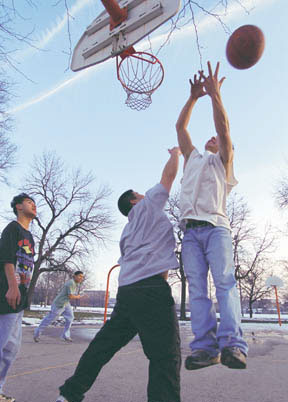 His store is southeast of Bridgeport Village and across the street from Tandem Developers’ new Union Lofts, 939 W. 35th St. More than half of the loft condos, priced from the $180s to the $370s, have sold. These are the kind of chic units Tandem has built farther north, with exposed beams and ducts, balconies, 12-foot ceilings and skyline views. It’s a new animal in Bridgeport, where condos of any kind are extremely rare.
His store is southeast of Bridgeport Village and across the street from Tandem Developers’ new Union Lofts, 939 W. 35th St. More than half of the loft condos, priced from the $180s to the $370s, have sold. These are the kind of chic units Tandem has built farther north, with exposed beams and ducts, balconies, 12-foot ceilings and skyline views. It’s a new animal in Bridgeport, where condos of any kind are extremely rare.
“These lofts and houses will be great for us,” Veliotis says. “We’re going to upgrade our whole operation. We’re thinking of expanding to the alley. Even without the new housing, we really need twice the space in our store to grab the business we could be getting in the area.”
Johhny O’s corner comprises the convenience store, which has a deli counter, a now defunct bar in back, and a hot dog stand with a service window on 35th Street. A sign advertises David Berg hot dogs, and another proclaims two dogs and fries for $1.99.
“My father had a restaurant in Homewood, but someone put a bug in his ear, he should get a cart, so he did,” Veliotis says. “He came to Bridgeport with a hot dog cart. I was out there hustling in front of Spiegel’s at 12 years old.”
But everything in Bridgeport is political, hot dog carts no exception.
“It used to be just us selling hot dogs, an Italian guy selling ice cream and a Jewish guy selling cookies,” Veliotis says. “Then the competition came and there were all kinds of people out there selling everything, costume jewelry and all kinds of things.”
There was a tense period when Veliotis says he had to “get rough with a couple of people,” but in the end, Spiegel ejected all the vendors. Veliotis opened the store and hot dog stand in 1970. In addition to running the business, he did a little boxing and sang jazz standards in nightclubs, as well as, on one special occasion, the National Anthem at Comiskey Park.
With his plans to remodel, Veliotis feels as if he’s starting over at age 69, but for a while he thought the business might not survive at all. When Spiegel closed its massive operation down the street, much of his customer base left.
The new housing has given him hope and his son a place to live. Peter, Veliotis’s 31-year-old son, recently bought one of the condos at Union Lofts. After a stint in Las Vegas, he has decided to stay in Bridgeport and work in the business. And in a new twist on an old scenario, instead of living above the store, the shopkeeper will be across the street in his new loft.
Most buyers at Tandem Lofts have been from the neighborhood or other parts of the South Side, and Bridgeport Village expects the same clientele. It remains to be seen whether such developments can draw North Siders, who don’t seem to realize most of the city exists south of Madison Avenue.
“Some people have North Side blinders on,” says Bill Lavicka, a developer who is converting a historic Bridgeport church into a luxury single-family home. “They’d rather live with winos and gangs on a terrible street on the North Side than in a nice neighborhood on the South Side. I’ve always said, we should make 110th Street Madison, so we’d all be North Siders.”
The church, which probably dates from the 1860s and later served as a German drinking hall and a stable, has 3,600 square feet and impeccable historical detailing, priced at $550,000.
Lavicka says that if he can’t find a buyer, he’ll rent the space until the neighborhood catches up – something he’s confident will happen. He cites rising property values and an influx of artists as positive signs for Bridgeport.
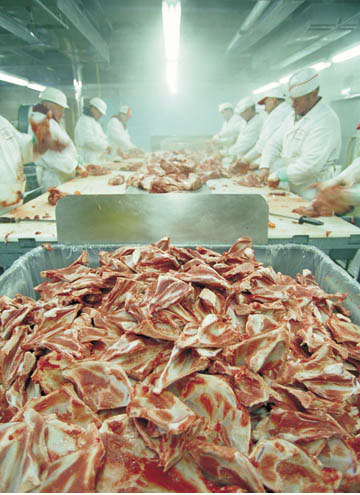 The best known of those artists are the Zhou Brothers, whose work fetches high prices in Europe. They came to Bridgeport from China in 1986 simply because it was near Chinatown and had the available space they needed for a large studio. They bought one of the prettiest buildings on Morgan Street, a former Polish club where the current Mayor Daley is rumored to have bused tables when he was in high school. Now, though the Zhous spend most of the year in Germany, they consider Bridgeport home.
The best known of those artists are the Zhou Brothers, whose work fetches high prices in Europe. They came to Bridgeport from China in 1986 simply because it was near Chinatown and had the available space they needed for a large studio. They bought one of the prettiest buildings on Morgan Street, a former Polish club where the current Mayor Daley is rumored to have bused tables when he was in high school. Now, though the Zhous spend most of the year in Germany, they consider Bridgeport home.
“I have no concept of neighborhood when I came here, but thought it was a cool place and near Chinatown,” says Dahuang Zhou in slightly clipped English. He’s standing across the street from his studio on Morgan, assessing their work. The brothers are installing ornate hand-carved screens over the windows today. They’ve also carved their own elaborate wooden doors for the studio and created a beautiful sculpture garden next door.
“It’s a nice place,” Zhou says. “All kinds of people. International people, local people, some young gangs, but it’s changing for the better. We have a lot of visitors to my studio and to Polo Café (3322 S. Morgan), and sometimes you see Rolls Royce and Mercedes next to old cars on the street.”
Polo Café and Catering, is something of a hidden gem in the city. Tucked away on this nondescript stretch of Morgan, it offers a glimpse into the past, and perhaps the future, of Bridgeport. The space has an original, ornate tin ceiling and original maple floors. The walls, painted with a deep green trim, hold antique lighting fixtures and shelves selling everything from pistachios and candy to flavored soda. The menu includes steaks and barbecued pork chops, tri-colored pasta and pan-seared swordfish. The food is excellent and the prices are low.
Owner Dave Samber is proof that at least one North Sider preferred Bridgeport’s uncongested streets and sense of community to the hectic anonymity of the Gold Coast. He bought the building at 3322 S. Morgan, built in 1914 as Kupsha’s Confectionary, 17 years ago and decided to open Polo, trading his highrise apartment for one above the store.
“People here live together, they don’t just dwell, which is what I was doing,” Samber says.
In 1997 he expanded Polo next door to include a stunning banquet facility, complete with 19-foot ceilings, a full bar, a stage, a loft and a Zhou Brothers original hanging near the entrance. His latest plans are to open a new restaurant across the street, at 33rd and Morgan. Smokin’ Harriet’s BBQ and Custard Too should be serving up ribs within a year, Samber says, on a stretch of Morgan that was once busier than Halsted.
Residents point out that in its heyday, there were three Polish bakeries on Morgan. But as the Poles and Lithuanians moved out, the street started to slip. The future of Morgan is anyone’s guess, but from Johhny O’s modest expansion plans, to Samber’s restaurants, the Zhou Brothers studio and city plans for new park space on the street, there are some positive signs.
My last stop of the day in Bridgeport is, of course, 3536 S. Loewe, the old home of Richard J. Daley, who served as mayor for more than 20 years and perfected the political machine. The last of the old-school bosses (not even Richard M. Daley wields the kind of control his father held) lived in this simple brick bungalow, which Mike Royko says in Boss contained books on only two subjects, religion and self-improvement.
I’m contemplating this when a police officer in an unmarked car calls the photographer over and demands to know what he’s doing there. Daley’s widow, Eleanor “Sis” Daley, still lives in the house, and it has 24-hour police protection.
No, she says, he can’t take a picture of the house.
But it’s a public street.
If he even tries to take a picture, she will have the station “send a car for us,” though she can’t think of what law we might be breaking. A 20-minute argument and calls to the local station follow, until a sergeant with enough authority finally tells the officer to let us take the picture, reluctantly endorsing the First Amendment.
We leave secure in the knowledge that no matter what happens in Bridgeport, some things will never change
